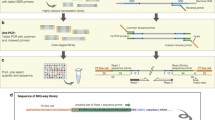Abstract
A microsatellite-containing clone, isolated from a pig Chromosome (Chr) 1-specific library was characterized by sequencing and computer analysis. The (CA)17 microsatellite motif was located at the 3′ end of a short interspersed element (SINE) sequence at the position normally occupied by the oligo (A) stretch. Further computer analysis indicated that 12% of published pig SINE sequences contain dinucleotide repeat motifs adjacent to their 3′ ends. By performing PCR with a single SINE primer in combination with a panel of arbitrarily selected unique primers, we have demonstrated that, as in human, polymorphisms can be detected and typed in pig family DNAs. A large number of SINE primer x unique primer combinations have been screened for the ability to detect polymorphisms in pig reference family DNAs. This approach does not require prior sequence information other than that of the pig SINE. We have also found polymorphisms at the 5′ ends of pig SINE sequences by similar methods, but with a primer facing out to the 5′ end of the SINE.
Similar content being viewed by others
References
Archibald, A.L., Brown, J.F., Couperwhite, S., and Haley, C.S. (1991). Reference families and markers for genetic mapping in the domestic pig, HGM 11. Cytogenet. Cell Genet. 58, 2123.1.
Charlieu, J.-P., Laurent, A.-M., Carter, D.A., Bellis, M., and Roizès, G. (1992). 3′ Alu PCR: a simple and rapid method to isolate human polymorphic markers. Nucleic Acids Res. 20, 1333–1337.
Devereux, J., Haeberli, P., and Smithies, O. (1984). A comprehensive set of sequence analysis programs for the VAX. Nucleic Acids Res. 12, 387–395.
Economou, E.P., Bergen, A.W., Warren, A.C., and Antonarakis, S.E. (1990). The polydeoxyadenylate tract of Alu repetitive elements is polymorphic in the human genome. Proc. Natl. Acad. Sci. USA 87, 2951–2954.
Epstein, N., Nahor, O., and Silver, J. (1990). The 3′ ends of alu repeats are highly polymorphic. Nucleic Acids Res. 18, 4634.
Frengen, E., Thomsen, P., Kristensen, T., Kran S., Miller, R., and Davies, W. (1991). Porcine SINEs: characterization and use in species-specific amplification. Genomics 10, 949–956.
Kaukinen, J. and Varvio, S.-L. (1992). Artiodactyl retroposons: association with microsatellites and use in SINEmorph detection by PCR. Nucleic Acids Res. 20, 2955–2958.
Litt, M. and Luty, J.A. (1989). A hypervariable microsatellite revealed by in vitro amplification of a dinucleotide repeat within the cardiac muscle actin gene. Am. J. Hum. Gen. 44, 397–401.
Miller, J.R., Dixon, S.C., Miller, N.G.A., Tucker, E.M., Hindkjær, J., and Thomsen, P.D. (1992). A chromosome 1-specific DNA library from the domestic pig (Sus scrofa domestica). Cytogenet. Cell Genet. 61, 128–131.
Miller, S.A., Dykes, D.D., and Polesky, H.F. (1988). A simple salting out procedure for extracting DNA from human nucleated cells. Nucleic Acids Res. 16, 1215.
Nelson, D.L., Ledbetter, S.A., Corbo, L., Victoria, F.I., Ramirez-Solis, R., Webster, T.D., Ledbetter, D.H., and Caskey, C.T. (1989). Alu polymerase chain reaction: a method for rapid isolation of human-specific sequences from complex DNA sources. Proc. Natl. Acad. Sci. USA 86, 6686–6690.
Parker, J.D., Rabinovitch, P.S., and Burmer, G.C. (1991). Targeted gene walking polymerase chain reaction. Nucleic Acids Res. 19, 3055–3060.
Sanger, F., Nicklen, S., and Coulson, A.R (1977). DNA sequencing with chain-terminating inhibitors. Proc. Natl. Acad. Sci. USA 74, 5463–5467.
Stallings, R.L., Ford, A.F., Nelson, D., Torney, D.C., Hildebrand, C.E., and Moyzis, R.K. (1991). Evolution and distribution of (GT)n repetitive sequences in mammalian genomes. Genomics 10, 807–815.
Tautz, D. (1989). Hypervariability of simple sequences as a general source for polymorphic DNA markers. Nucleic Acids Res. 17, 6463–6471.
Weber, J.L. and May, P.E. (1989). Abundant class of DNA polymorphisms which can be typed using the polymerase chain reaction. Am. J. Hum. Gen. 44, 388–396.
Winterø, A.K., Fredholm, M., and Thomsen, P.D. (1992). Variable (dG-dT)n-(dC-dA)n sequences in the porcine genome. Genomics 12, 281–288.
Yuille, M.A.R., Goudie, D.R., Affara, N.A., and Ferguson-Smith, M.A. (1991). Rapid determination of sequences flanking microsatellites. Nucleic Acids Res. 19, 1950.
Zuliani, G. and Hobbs, H.H. (1990). A high frequency of length polymorphisms in repeated sequences adjacent to Alu sequences. Am. J. Hum. Genet. 46, 963–969.
Author information
Authors and Affiliations
Rights and permissions
About this article
Cite this article
Miller, J.R., Archibald, A.L. 5′ and 3′ SINE-PCR allows genotyping of pig families without cloning and sequencing steps. Mammalian Genome 4, 243–246 (1993). https://doi.org/10.1007/BF00417429
Received:
Accepted:
Issue Date:
DOI: https://doi.org/10.1007/BF00417429




